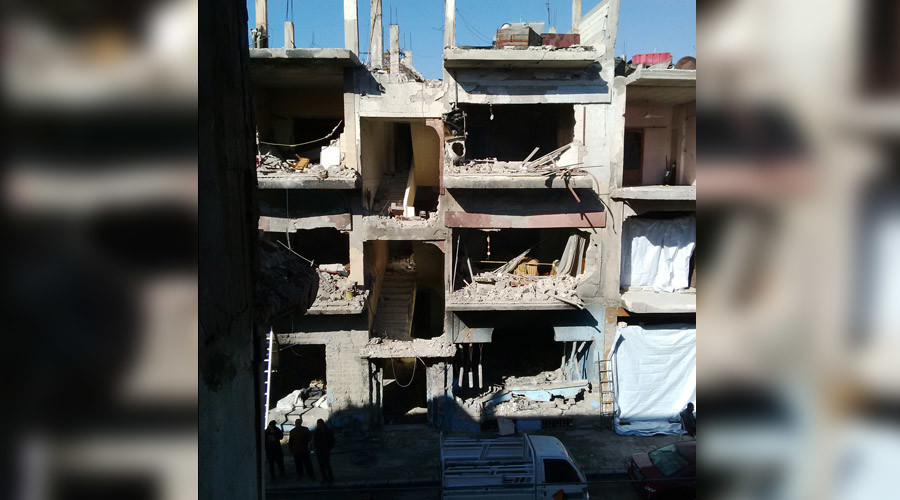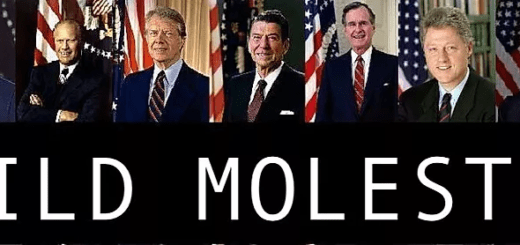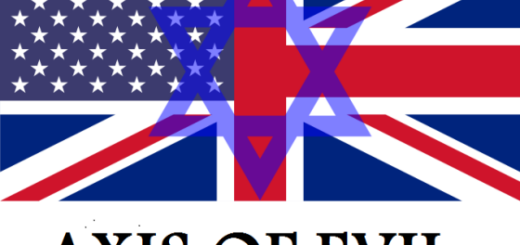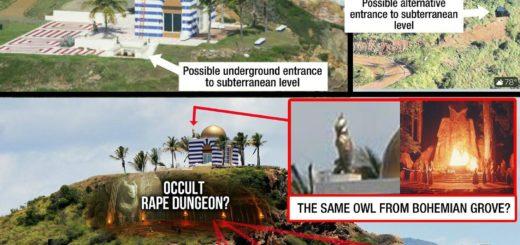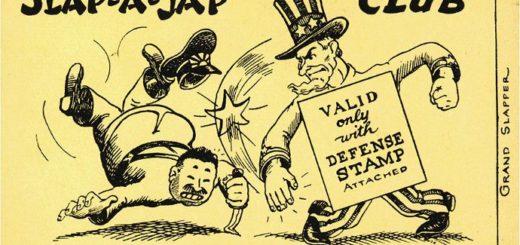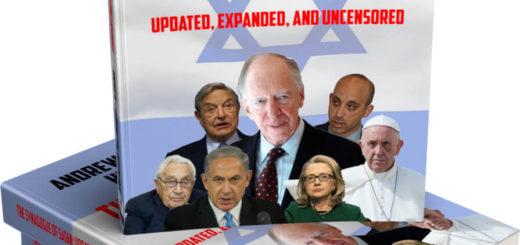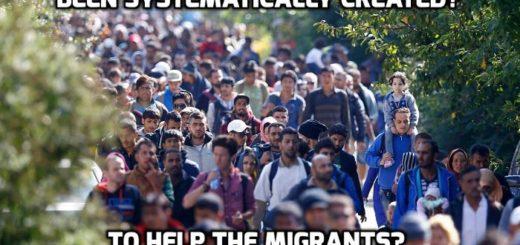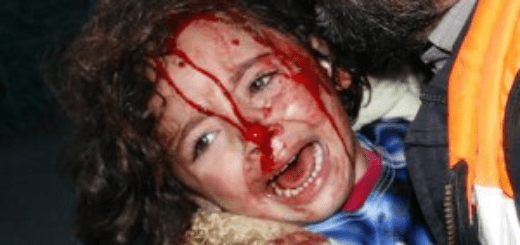By @EvaKBartlett | November 29, 2016
–MintPressNews (on Facebook) (republished at: Global Research, SOTT)
Al-Layramoun and Bani Zaid are home to the same landscape of battered buildings that one finds in areas where militants have bunkered deeply down. Seeing the destruction, some of the other journalists in our delegation mention only the physical damage to the buildings. “Buildings lay pancaked by airstrikes,” one wrote, pointing an incriminating finger at the Syrian government without giving any context as to why these areas were hammered.
The real shame is not actually the physical destruction of buildings, but the incursion into these districts by Western-backed terrorists, including the Free Syrian Army, the Nusra Front, and Da’esh, among others. Nearly six years into the needless bloodshed, their criminal and savage acts against Syrian civilians and soldiers are well-documented. And it’s common knowledge that they bunker down to avoid airstrikes.
The Free Syrian Army’s nine suffocating, improvised metal solitary confinement cells and three rooms used as regular cells in the underground prison bunker in al-Layramoun were all intact despite the aerial bombings. Buildings are devastated above-ground because of the presence of militants deep underground, where airstrikes inflict considerably less damage.
18 killed in Nov. 3 terror attacks
On the afternoon of Nov. 3, after meeting with Dr. Mohammed Batikh, director of Al-Razi Hospital, the victims of terror attacks which had begun a few hours prior began to arrive one after another, maimed and critically injured. The vehicle bombings and bombardment of Grad missiles, among other attacks, left 18 people dead and more than 200 injured, according to Dr. Zaher Hajo, the head of forensic medicine at Al-Razi Hospital.
 The body of a civilian who was killed in the Nov. 3 attacks in Aleppo. Nov. 3, 2016. (Photo: Eva Bartlett)
The body of a civilian who was killed in the Nov. 3 attacks in Aleppo. Nov. 3, 2016. (Photo: Eva Bartlett)
The corridors and emergency ward at Al-Razi Hospital, one of two state-run hospitals in Aleppo, quickly became clogged with the injured and grieving family members. In one crowded interior corridor, one of the wounded screamed out in pain: “Ya, Allah! Ya, Allah!”
In another corridor, a 15-year-old boy with a cast on one leg and bandages on his head, said the mortar attack which injured him had killed his 4-year-old cousin and left his 6-year-old cousin with critical injuries.
In a front room, a mother wailed for her son who had suffered severe injuries. She screamed and pleaded for someone to save him, her only son. Not long after, though, the news came in: the 26-year-old had died. Her son, a doctor, was not the first medical professional to die in terrorists’ routine bombings of Aleppo neighborhoods.
Dr. Nabil Antaki, a gastroenterologist from Aleppo, with whom I met on my trips to Aleppo in July and August, messaged me in October about his friend and colleague, Dr. Omar, who was injured on Oct. 6 when terrorist factions unleashed an attack on Jamiliye Street, killing 10 people. Just a few days after the attack, Dr. Omar, too, died.
At the morgue behind Al-Razi Hospital on Nov. 3, inconsolable family members leaned against the wall or sat on the pavement, coming to grips with the deaths of loved ones.
One 14-year-old boy had been there on Nov. 2, when his father was killed. On Nov. 3, he returned when his mother was killed. Both of this boy’s parents are dead, both killed in terrorist attacks on the city’s New Aleppo district.
A man spoke of a 10-year-old nephew who was shot in the head by a terrorist sniper while the boy was on his roof.
A woman and her children leaned against an iron rail next to the door to the morgue, weeping over the death of her husband, their father, who was killed while parking a car. When the man’s mother arrived, she collapsed, shrieking in grief.
 The body of a civilian who was killed in the Nov. 3 attacks in Aleppo. Nov. 3, 2016. (Photo: Eva Bartlett)
The body of a civilian who was killed in the Nov. 3 attacks in Aleppo. Nov. 3, 2016. (Photo: Eva Bartlett)
And in the midst of all of this, all these women and children, a car arrived at the morgue with the body of yet another victim of the day’s terror attacks, Mohammed Majd Darwish, 74. His upper body was so bloody that it was unclear whether he had been decapitated.
Near the morgue, Bashir Shehadeh, a man in his forties, said his family had been displaced already from Jisr al-Shughour, a city in Idlib. His mother, some of his friends, and his cousin have been killed by terrorist factions’ shellings. He said enough was enough, and called on the SAA to eliminate the terrorist threat.
Al-Razi’s Dr. Batikh said a private hospital, Al-Rajaa, was hit by a mortar attack. “They cannot do operations now, the operating room is out of service.”
One of the most notable attacks on hospitals was the December 2013 double truck bombing of Al-Kindi Hospital, the largest and best cancer treatment hospital in the Middle East. I have previously reported on other attacks on hospitals in Aleppo, including the May 3 rocket attack which gutted Al-Dabeet, a maternity hospital, killing three women. On Sept. 10, Dr. Antaki messaged me:
“Yesterday, a rocket, sent by the terrorists, hit a maternity hospital in Aleppo in Muhafazat Street. Two persons working in the hospital were injured. No death. But the point is that it is a hospital and it was hit by a rocket.”
Dr. Batikh and Dr. Mazen Rahmoun, deputy director of Al-Razi, said the hospital once had 68 ambulances, but now there are only six. The rest, they said, were either stolen by terrorist factions or destroyed.
Aleppo’s doctors continue to treat the daily influx of injured and ill patients in spite of the dearth of ambulances and effects of Western sanctions which mean a lack of medical equipment, replacement parts, and medicine for critical illnesses like cancer.
According to the hospital’s head forensic medicine, Dr. Hajo, in the last five years, 10,750 civilians have been killed in Aleppo, 40 percent of whom were women and children. In the past year alone, 328 children have been killed by terrorist shelling in Aleppo, and 45 children were killed by terrorist snipers.
Humanitarian Crossings: Shelling of Castello Road
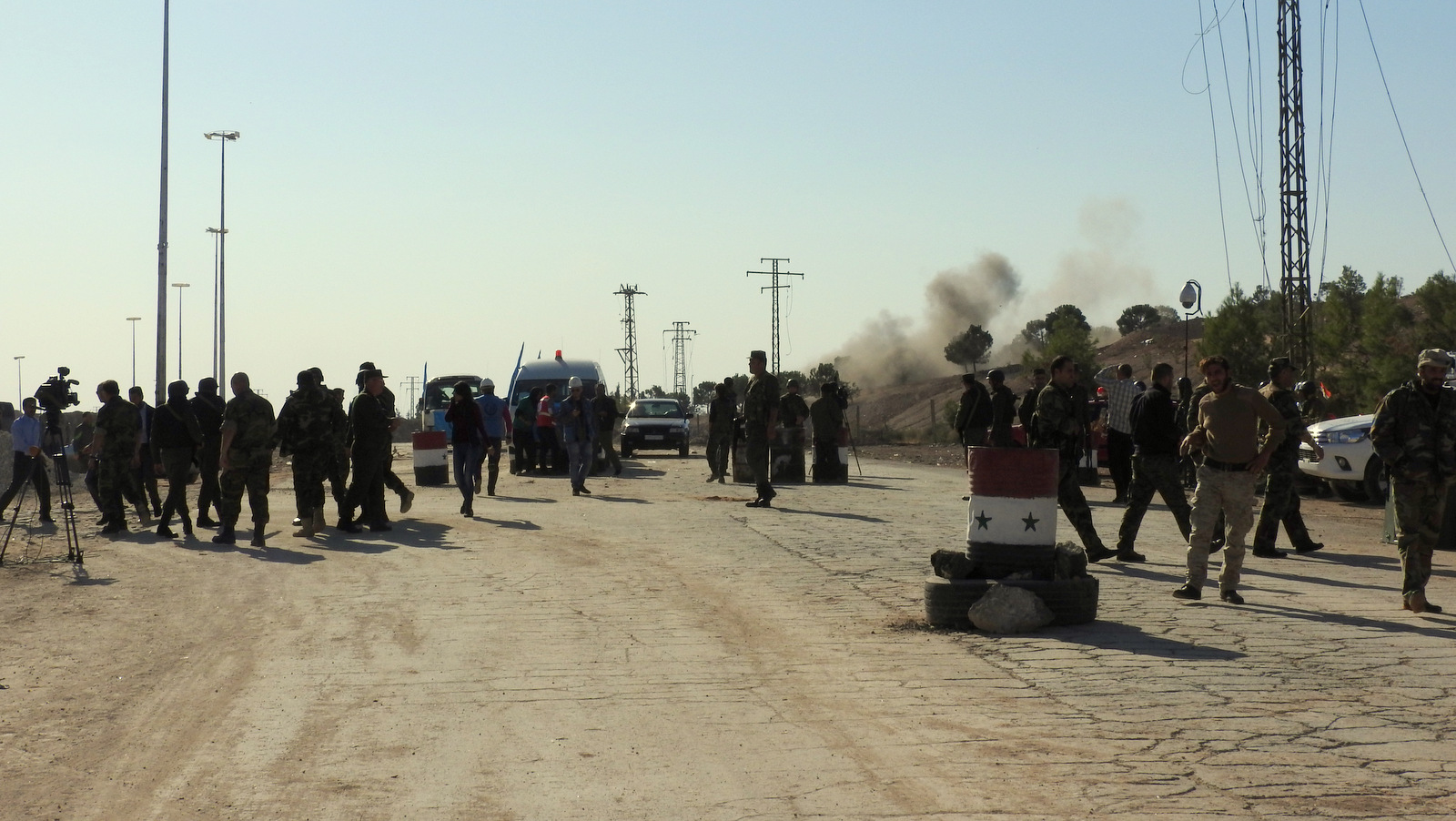 Less than 100 metres away, the second of two mortars fired by terrorist factions less than 1 km from Castello Road on Nov. 4. The road and humanitarian corridor were targeted at least six times that day by terrorist factions. Nov. 4, 2016. (Photo: Eva Bartlett)
Less than 100 metres away, the second of two mortars fired by terrorist factions less than 1 km from Castello Road on Nov. 4. The road and humanitarian corridor were targeted at least six times that day by terrorist factions. Nov. 4, 2016. (Photo: Eva Bartlett)
On Nov. 4, prior to our 9:30 a.m. arrival at the Bustan al-Qasr crossing and until our departure an hour later, no one had been able to cross from the area just beyond crossing, which is occupied by Jaysh al-Fatah militants.
Two weeks prior to our arrival, journalists had reported that terrorist factions heavily shelled the crossing and areas around it starting in the early morning.
A Syrian general at the crossing confirmed that shelling had taken place on Oct. 20, adding that three police officers had been wounded. A journalist in the delegation asked the general what he would say to Syrian civilians like Bashir Shehadeh, who demanded that the SAA eliminate the terrorist factions.
“We need to be patient, because the civilians there are not able to leave, they are not guilty,” the general replied. “We don’t work the way that the terrorists work.”
Regarding the amnesty decree issued by President Bashar Assad in late July, the general explained that terrorists who want to be granted amnesty could lay down their arms. Those who choose to go on to Idlib would be granted safe passage by the Syrian government and army, in coordination with the Red Cross and Red Crescent.
According to the general, when two militants arrived at the Bustan al-Qasr crossing about two months ago, they surrendered their arms and proceeded under amnesty.
Five months ago, he said, 12 civilians crossed there, were treated in Aleppo’s hospitals, and returned to their homes in terrorist-held eastern Aleppo.
At the Castello Road humanitarian crossing, the large green buses which were said to be evacuating militants from areas of eastern Aleppo in recent weeks were there again, waiting to ferry away more. Ten ambulances, three buses, and 14 minivans were lined up in anticipation of any civilians or militants trying to leave terrorist-occupied areas, whether for safe passage elsewhere or to settle in government-secured areas of Aleppo.
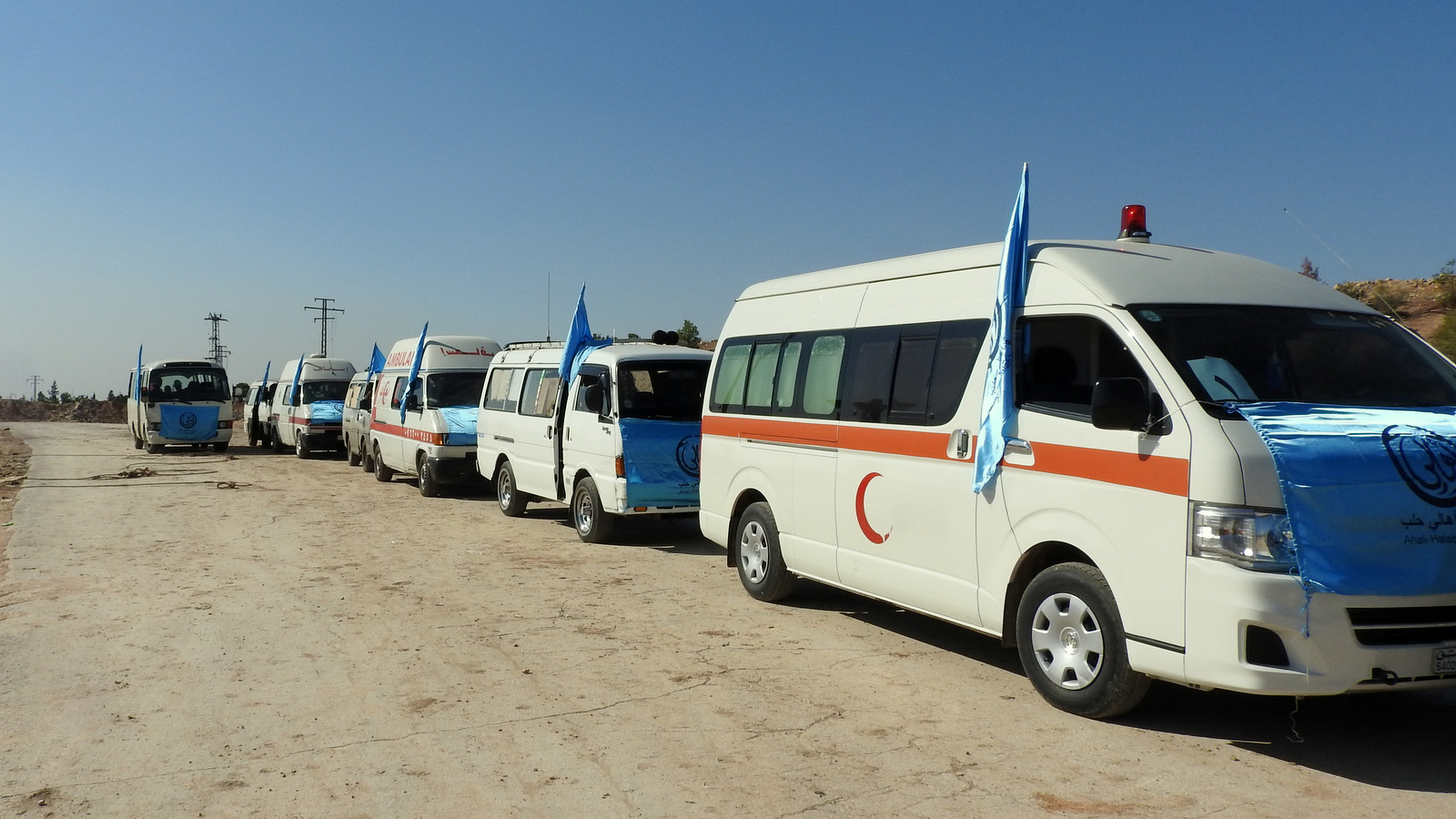 Ten ambulances wait at the Castello Road crossing to treat anyone exiting via the humanitarian corridors established by the Syrian government and Russia, including militants who lay down their arms. Nov. 4, 2016. (Photo: Eva Bartlett)
Ten ambulances wait at the Castello Road crossing to treat anyone exiting via the humanitarian corridors established by the Syrian government and Russia, including militants who lay down their arms. Nov. 4, 2016. (Photo: Eva Bartlett)
George Sire, 25, an anesthesiologist at Salloum Hospital in Aleppo, was one of the volunteers who arrived at the crossing with five of the private hospital’s ambulances, at the request of the Syrian government.

When speaking with a Syrian commander about permitting men who had used arms against Syrian civilians and soldiers to lay down their arms and reconcile, he said they are sons of the country and urged them to reconcile.
At around 1:30 p.m. the first shell struck, hitting near Castello Road. About 10 minutes later, while I was being interviewed, a second hit, this time considerably closer, within 100 meters — close enough, in fact, to create a cloud of dark smoke over the road. It prompted security to usher me away from the road and move our delegation away from the crossing.
I later learned that another five shells targeted the crossing, injuring a Syrian journalist and two Russian soldiers.
No one passed through this or any of the other seven humanitarian corridors that day.
Displaced by terrorists
For around four years, simple shelters at the Hafez al-Assad Mosque have housed around 1,000 people, all Sunni families displaced from areas occupied by militants.
Most of those with whom I spoke listed similar reasons for leaving their homes and described being in fear for their lives because of the terrorist presence.
“They came and destroyed houses and killed civilians before they attacked the state. The army is protecting us, it’s the gangs [that] are the ones destroying the country,” one man told me.
He said his two brothers in terrorist-controlled areas in eastern Aleppo are “not allowed to leave.”
“They’ve tried many times but they are prevented. If the armed groups see anyone carrying luggage, they’ll arrest them right away.”
He and others at the shelter complained that, according to their family members, the terrorist factions horde and control any food within the areas they occupy.
Like elsewhere in the city, the shelter and area immediately surrounding the mosque are routinely hit with mortars and explosive bullets.
An older man led me around a corner, pointing to a spot where he said a 29-year-old man was killed by a terrorist-fired explosive bullet.
“He was standing here. His stomach was torn open,” he told me.
The Old City: Life among ruins
 *Small plot of herbs planted by soldiers on duty in the Old City of Aleppo.
*Small plot of herbs planted by soldiers on duty in the Old City of Aleppo.
The small bus ferrying over a dozen journalists and a very alert special forces soldier, Ali, to the Old City at one point suddenly bolted ahead. A sniper was staked out to our left, in an area occupied by terrorist factions roughly 500 meters away, we were told.
After entering the Old City, and crossing a street shielded from sniper fire by an earthen embankment and a metal screen, at times the only means of continuing on in the Old City was by stepping through holes hammered into the walls connecting buildings. By crossing through buildings, we avoided the snipers who are ready fire on anyone who moves on the street.
Across the narrow street, a shock of greenery stood in stark contrast to the grey tones of destruction created by years of fighting against some of the worst terrorism the world has ever known.
Rami, a Syrian soldier from Banias, explained that he had planted herbs and green onions here as he did when he had been stationed along the desert-like Ithriya-Khanasser road in the past. Rami’s soft smile and kind demeanor betrayed his personal loss: a brother killed while serving in the SAA.
While walking through the government-secured areas of Aleppo’s Old City, we came across a single vendor, Mahmoud. He used to sell traditional Arabic musical instruments, but circumstances have forced him to abandon that business in favor of selling basic goods to roughly 25 customers per day. He refuses to leave the Old City, where he’s only about 200 meters from the Nusra Front and other Jaysh al-Fatah militants.
“I’m an ordinary person,” Mahmoud said. “They destroyed everything.”
Walking past devastated shop after devastated shop, and through the graceful arches of covered markets typical of old Syrian cities, MP Fares Shehabi pointed out:
“You see the blackened ceilings? That’s from when the terrorists withdrew. They set fires to stall the advance of the Syrian army, and also to try to hide their looting. They cannot accuse the army of having bombed here, the roof is intact.”
Exiting from this particular market area, we came to a sandbagged, partially-screened area. We were given stern orders not to move forward: The famous Aleppo Citadel was ahead, and to the left and right of our position at the destroyed Carlton Hotel, terrorist snipers lay in wait.
When terrorists detonated mass amounts of explosives in tunnels underneath the Carlton Hotel in May 2014, Col. Abu Majed told us that “all of Aleppo felt it.”
“They have bombed over 20 historic buildings via tunnels,” Shehabi said. “If they were real Syrians, they would not bomb historical buildings.”
At least 7,500 shops in the Old City are gone, lost to burning, looting and utter destruction. “That’s 7,500 families,” Shehabi reminded us.
Visiting frontline targeted areas
The Syrian Catholic Church of Aleppo still has a gaping hole in one wall since being hit by terrorist shelling roughly two years ago. At the time of the attack, the congregation was inside worshipping, the choir singing.
 The Syrian Catholic Church of Aleppo has been targeted with shelling five times by terrorist groups, including the Nusra Front, that occupy areas just 500 meters away. The shelling that left this hole occurred two years ago, while congregation members were worshipping, the choir singing. At least 10 people were injured. Nov. 2, 2016 (Photo: Eva Bartlett)
The Syrian Catholic Church of Aleppo has been targeted with shelling five times by terrorist groups, including the Nusra Front, that occupy areas just 500 meters away. The shelling that left this hole occurred two years ago, while congregation members were worshipping, the choir singing. At least 10 people were injured. Nov. 2, 2016 (Photo: Eva Bartlett)
A church leader said it had been targeted five times, the last incident apparently involving a rocket just a few weeks prior to our arrival. Terrorist factions were an estimated 300-500 meters away, he said.
He estimated that one-third of the 1,350 families who used to worship there have fled to other areas of Syria or abroad, mainly due to safety concerns.
“We were living in security and peace. These areas are being targeted, they want to force us to leave. Every Syrian is being targeted,” he told the delegation.
Some of the remaining congregation members have chosen to worship in a narrow corridor inside the building over the past two years.
Further in the city, the Maronite Church of Aleppo’s Bishop Joseph Topji said roughly two-thirds of his community of around 800 families have left, hoping to find safer conditions elsewhere.
Inside a building belonging to the church, Bishop Topji welcomed us and explained:
“We don’t have a church now. We used to have two churches, but both are destroyed. We only have this place, a chapel which holds around 70 people.”
Walking along darkened streets in Talal, an area historically rich with churches that are now destroyed or massively damaged, Shehabi urged caution: “We are 50 meters from al-Nusra. Beyond these buildings, the frontline.”
Rev. Ibrahim Nseir, pastor of the Arab Evangelical Presbyterian Church of Aleppo, led us through the Christian areas of Talal, reminding us to remain as silent as possible.
“No voices, because that will let them hear that we are here. It will be very dangerous,” he said quietly. “Quickly, ya eini… Please, everybody, quickly…”
We then took a bus to Midan district, where we walked along the darkened streets. Our Syrian military accompaniment urged the group to stay together and listen carefully.
As we walked, Rev. Nseir described attacks on schools and the area, an Armenian district, which was heavily hit.
“Here we are in one of the most targeted places,” he said, pointing out ruts in the ground from mortar strikes.
A local resident told us:
“On September 5, two gas canister bombs his this area, we had three martyrs, shebab around age 30. One was married with a 1-year-old child. Another was about to get married. Four days before his wedding, he was killed. Over six days in September, we received 85 shells.”
As we walked, Shehabi cautioned: “Bela dow, bela dow—no light. There’s a sniper, guys, there’s a sniper. Turn off your lights.” The sniper was an estimated 1 km away, according to the locals walking with us, who said snipers sometimes come within 500 meters.
With night settled in, it was difficult to ascertain the intensity of the damage, but the darkened homes and streets spoke volumes of a neighborhood abandoned by former residents with deep safety concerns.
 According to a representative of the Syrian Catholic Church of Aleppo, around one-third of the congregation’s 1,350 families have fled to other areas of Syria or even gone abroad, primarily seeking security and distance from the mortars and rockets of terrorist factions. Congregation members stopped worshiping in the church chapel two years ago after repeated instances of shelling. They now gather in a small interior corridor where they feel somewhat safer. Nov. 2, 2016. (Photo: Eva Bartlett)
According to a representative of the Syrian Catholic Church of Aleppo, around one-third of the congregation’s 1,350 families have fled to other areas of Syria or even gone abroad, primarily seeking security and distance from the mortars and rockets of terrorist factions. Congregation members stopped worshiping in the church chapel two years ago after repeated instances of shelling. They now gather in a small interior corridor where they feel somewhat safer. Nov. 2, 2016. (Photo: Eva Bartlett)
Aleppo’s religious leaders defy divisiveness
Inside his church, a new structure built about a year ago to replace the historic church destroyed by terrorists in years prior, Rev. Nseir introduced three Sunni leaders from the city: Dr. Rami Obeid, Dr. Rabih Kukeh, Sheikh Ahmed Ghazeli.
“These Sunni leaders are considered ‘infidels’ by al-Nusra and company,” Nseir said, explaining that they don’t follow the distorted Wahhabi ideology guiding the Western-backed terrorist factions like the Nusra Front and others which had been deemed “moderate rebels” and “opposition forces.”
Before turning the floor over to these religious leaders, Rev. Nseir noted:
“When the church was destroyed, the first person to call me was Mufti Hassoun, who told me, ‘Don’t worry, reverend, we’ll rebuild the church.’”
Dr. Kukeh spoke generally on the multi-denominational culture of Syria:
“The mosaic we are living in Syria is incomparable to any way of living all over the world. Christians and Muslims, Sunnis and Shiites. There is no discrimination based on religion or sect. The propaganda spread throughout the media have no roots here.”
 Rev. Ibrahim Nseir, pastor of the Arab Evangelical Presbyterian Church of Aleppo, with three top Sunni scholars and leaders, Dr. Rami Obeid, Rabih Kukeh, Sheikh Ahmed Ghazeli, who reject Wahhabism. Dr. Kukeh said of the terrorist factions: “Those who are killing the Sunnis are the same who claim that they are defending the Sunnis.” Nov. 2, 2016. (Photo: Eva Bartlett)
Rev. Ibrahim Nseir, pastor of the Arab Evangelical Presbyterian Church of Aleppo, with three top Sunni scholars and leaders, Dr. Rami Obeid, Rabih Kukeh, Sheikh Ahmed Ghazeli, who reject Wahhabism. Dr. Kukeh said of the terrorist factions: “Those who are killing the Sunnis are the same who claim that they are defending the Sunnis.” Nov. 2, 2016. (Photo: Eva Bartlett)
In regards to the terrorists who portray themselves as freedom-fighting jihadists, Dr. Kukeh said:
“Those who are killing the Sunnis are the same who claim that they are defending the Sunnis. The shells that hit us daily are sent by them.”
He named six Sunni sheikhs in Syria, most in Aleppo, who were assassinated by terrorists for not joining them. One of them, Sheikh Abdel Latif al-Shami, was tortured to death in July 2012.
Dr. Kukeh, who said he named his oldest son after the former Hezbollah leader, Hassan Nasrallah, “because I love that man,” explained that in 2012 he was living in eastern Aleppo when terrorists began to occupy districts there. He was targeted for assassination because he did not agree with the terrorists’ ideologies.
He said he was convicted of charges related to his writing for a local publication, his son’s name, and a lack of anti-government demonstrations emanating from his mosque. Those demonstrations never occurred, he said, because he never encouraged them like other Wahhabi sheikhs did elsewhere.
The conversation drifted from the source of terrorism in Syria, Wahhabism, and its distorted, un-Islamic nature, to the unity I’ve heard Syrians all over speak of. One of the sheikhs, his name lost in a flutter of voices, repeated what’s become a familiar sentiment among Syrian civilians and soldiers:
“Aleppo is one, Syria is one. We reject the division of Aleppo, we reject the division of Syria.”
 *The author with a Syrian soldier stationed to defend of Aleppo’s Old City.
*The author with a Syrian soldier stationed to defend of Aleppo’s Old City.

![On Oct. 20 and again on Nov. 4, the Syrian government and Russia opened eight humanitarian corridors established for civilians and militants who wished to flee terrorist-held areas of eastern Aleppo, including militants who wished to surrender their weapons under amnesty. However, no one left on Nov. 4. Many residents within eastern Aleppo have said they are being held hostage and used as human shields by terrorists who shoot upon people attempting to leave through the humanitarian corridors. [Photo by Eva Bartlett, Nov. 4, 2016]](http://www.mintpressnews.com/wp-content/uploads/2016/11/Bustan-al-Qasr-district-of-eastern-Aleppo.jpg)
